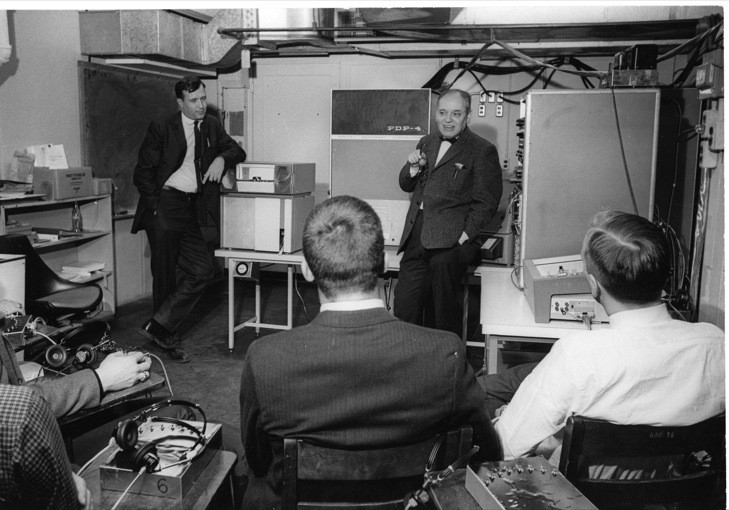On September 26-27, CAST is convening artists, neuroscientists and scholars in the visual arts, music, physics, mathematics, history, anthropology and philosophy to participate in the symposium “Seeing / Sounding / Sensing.” Organized by MIT Professors Caroline A. Jones (Chair) and Stefan Helmreich, along with Mellon postdoctoral fellow David Mather, the symposium is part of a recent intellectual concern for forging a new approach to the study of the senses that is more synthetic, multidisciplinary and multisensory. Historically, the view of the senses has ranged from rigidly independent to synesthetic, and in fact these views often co-exist within the same culture and period.

For Aristotle, the senses were distinct. In De Anima, he describes sight, hearing, smell, taste and touch individually, and in that hierarchical order. The Aristotelian view dominated Classical and later medieval discourses on the senses. While later scholars also espoused the classical tradition, new scientific ideas were introduced in the late seventeenth and early eighteenth centuries. René Descartes and Johannes Kepler presented the physiology of the senses within an entirely new theoretical framework. Descartes ascribed to the senses a purely physical function, unlike Aristotle, and Kepler contributed discoveries grounded in empirical research. He measured and assessed eyesight using optical aids (e.g. spectacles, the telescope, the camera obscura), which were increasingly available in the early modern period. Ever-changing technological developments allowed for new forms of sensory experience and substantiated the idea that the senses were distinct in their functions and physiological forms.

At once a product of Enlightenment thought and a harbinger of the more synesthetic view of sense perception that developed in the Romantic period, Louis Castel, with his ocular harpsichord, is a transitional figure. In France in 1725, Castel responded to the philosophical ideas of Athanasius Kircher and conceived of an ocular harpsichord, a color organ that would display the chromatic equivalent for each musical note sounded by the unique instrument. For his quest to link sound and vision, Castel was considered at turns a lunatic — lampooned mercilessly in the press — and a genius by his contemporaries. In his words, he aimed “to make harmony, and almost music, enter in at the eye, as it has hitherto done at the ear,” and “to make a blind man judge of colors, and the deaf judge of sounds.” This ambition to make sound seen and color heard intrigued Voltaire and later Goethe, and it gained traction in subsequent centuries when other musicians, artists and philosophers re-imagined the color organ.
This episode in 18th-century France is a vivid example of the ambition to explore the interconnectedness of sensory experience. Until relatively recently, researchers across different disciplines in neuroscience and psychology used a modality-specific “sense-by-sense” approach to study sensory experience. CAST’s symposium aims to address the most recent findings in cognitive research and create a dialogue around topics of common concern among artists, humanists and scientists. The goal is to challenge each domain’s conventional certainty about “what is known,” “how we know it,” or “how we can know more,” in the words of symposium organizers, and to stimulate new issues for cross-disciplinary scholarship in the future.
An integrative approach to sensory studies, currently the dominant trend, has over a half-century history at MIT. In 1959, Professor Walter Rosenblith, whose pioneering Communications Biophysics Laboratory (CBL) in the Research Lab for Electronics (RLE), organized the two-week multidisciplinary international “Symposium on Principles of Sensory Communication,” which was by all accounts the most expansive (in terms of disciplines represented) and most successful event of its kind until that date. The proceedings were published in 1961 as Sensory Communication and, due to the book’s exceptional continued influence, it was reprinted by MIT Press in 2012. Professor Tomaso Poggio, a participant in CAST’s symposium, notes that this publication was “one of the key catalyzers” in the “intellectual ferment that eventually converged into the ambitious attempt of understanding intelligence and of replicating it in machines – the harbinger of today and tomorrow’s intelligent machines.”

For this occasion, CAST aims to broaden the discussion to include artists and scholars from the arts and humanities, together with researchers from various branches of the sciences. “Seeing / Sounding / Sensing” takes its place within this trajectory of MIT’s artificial intelligence research, but also departs from it in responding to a current global interest in sense studies within the humanities and social sciences. The goal, according to Jones, is to restore a conversation between cognitive scientists and these other fields and to expand the questions asked in all these domains.
Bruno Latour (Professor, Sciences PO Paris) will open the symposium with the keynote address, touching on the philosophical underpinnings of the topic, including the notion of a “common sense.” Poggio (Eugene McDermott Professor of Brain and Cognitive Sciences, McGovern Institute and CSAIL, and Director of the new NSF Center for Brains, Minds and Machines at MIT) will offer a commentary, by describing his research on models of vision, learning and human intelligence. The symposium concludes with a concert featuring Alvin Lucier’s renowned I am Sitting in a Room, along with In Memorium Jon Higgins, performed by Evan Ziporyn (Faculty Director of CAST and Kenan Sahin Distinguished Professor of Music), and Spin Ensemble, composed and performed by Arnold Dreyblatt (CAST Visiting Scholar). The event artfully weaves together theoretical discourse and experiential understandings of sense perception.
“Seeing/ Sounding/ Sensing”
September 26-27, 2014
Presented by MIT Center for Art, Science & Technology (CAST)
